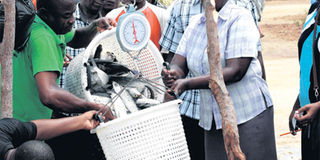Group finds room in ponds for marine fish

Baraka Group members with their milkfish harvest in Kwale. PHOTO | LABAN WALLOGA | NATION MEDIA GROUP
What you need to know:
- Each of the persons in the group of about 10 men and women were eager to see how many kilos the shoal of fish weighed.
- Merriam-Webster Dictionary describes milkfish as “a large fork-tailed silvery herbivorous food fish (Chanos chanos) of warm parts of the Pacific and Indian Ocean”.
- During the months, the fish breeds in the deep sea and the seeds are swept to the shoreline in shallow waters in the mangroves.
Their big eyes and slender bodies made them stand out as a group of farmers put them in a plastic basket hanging on a weighing scale.
Each of the persons in the group of about 10 men and women were eager to see how many kilos the shoal of fish weighed.
It was harvesting day for the members of Baraka Conservation, Milkfish and Prawn Group in Makongeni, Kwale, who ended up with 640kg of milkfish on that day. The group is pioneering the farming of milkfish in the larger Coast region.
Merriam-Webster Dictionary describes milkfish as “a large fork-tailed silvery herbivorous food fish (Chanos chanos) of warm parts of the Pacific and Indian Ocean”.
The 25 members have constructed earthen ponds with aid of the government’s Kenya Coastal Development Project and are breeding juveniles (fish stage after hatching from eggs into larvae) for supply on order.
Besides the juvenile fish, the group stocks four ponds with 3,600 fingerlings each.
Juma Mwarandani, a coordinator of the group, says the juveniles are captured from the ocean and kept in a floating cage that holds at least 5,000 of them for about a month to become fingerlings, when they are transferred to ponds.
“We started the mariculture project as a group in 2013 by keeping milkfish, barracuda, mullet, grouper, red snapper, white snapper, zebra fish and parrot fish. But we found that milkfish and barracuda were adapting to the environment well,” says the 42-year-old. They sell the fingerlings from Sh10 to Sh15 while mature fish goes for Sh200 a kilo.
“Last year, we sold 64kg, which earned us Sh128,000. This year things are good because our harvest has so far increased significantly.” Getting the juvenile fish is not an easy task. Members of the group hunt for them in open sea twice a year in April to June and October to December seasons. “We breed the juveniles because marine fish starts to lay eggs at five years when they weigh between 3 to 4kg. They need special tanks and skills that we do not have.”
During the months, the fish breeds in the deep sea and the seeds are swept to the shoreline in shallow waters in the mangroves.
They make their own feeds from omena, cassava flour that acts as a binder, coconut trashes to make pellets that are rich in carbohydrates and protein.
Kenya Marine and Fisheries Research Institute aquaculture research officer David Mirera says they are working with farmers to develop hatcheries to boost mariculture so that residents can stop going to fish in the ocean.





